
Palo Alto Unified School District’s ethnic studies course features a focus on examining students’ power and privilege, including ‘white privilege;’ uses a document which states that discussions and content will bring ‘discomfort’ and ‘anger’
Incidents
- Issues
- Ethnic Studies
Palo Alto Unified School District’s ethnic studies course features topics such as white privilege, oppression, power, and white supremacy. Course materials include an exercise on examining privilege and power and utilizes the “Wheel of Privilege.” Topics include “Black resistance” and the Black Panther Party Ten-Point program.
The unit titled “Power, Privilege, and Oppression” includes essential questions such as:
- “Can someone have privilege in one area of their life and experience oppression in another? (Intersectionality)”
- “How do our social identities influence the power and privilege we hold?”
- “How much power do I have in my society?”
- “How can privilege impact identity?”
- “How do power, privilege, and systems of oppression impact how we remember events?”
One of the weekly topics examines “structural power” and how it has affected various ethnic groups. Students learn about the “4 I’s of Oppression” and respond to a prompt connecting “White Privilege” to the “Wheel of Power/Privilege.”


The unit also includes a document listed as “Ethnic Studies Shared Understandings,” but is actually titled “Shared Understanding when studying and discussing Privilege and Power and other uncomfortable topics!”
The document states that students should be “uncomfortable together” because “it’s hard to talk about oppression in our society.” Another paragraph titled “People of privilege may be challenged by this course” states that students will “probably feel guilty at times” and “probably be defensive” but calls upon students to embrace these feelings and think of times they “have been oppressed or marginalized.” Students are asked how “can that discomfort be a means of empathizing with the pain of oppression.”
It also states that “having privilege does not mean that your life has been easy” and that privilege too can “cause life ‘troubles.'”
Another section titled “We are at different points on the learning curve related to structural oppressions” states that “some of us, by virtue of our skin color, class background, or awareness/experience, will be very aware of dynamics related to oppression” while “some of you will have no clue.” It also shares that “even straight white males can feel marginalized at given points in their journey through life.”
It concludes by stating that “anger is a completely appropriate response to injustice” and cautions students that it is “not useful to compare oppression.”

The unit titled “Resilience and Resistance” asks students how “different ethnic groups adapted traditional forms of resistance to contemporary situations” and how do “different acts of resistance create hope, healing, and spaces for positive change?”
Students learn about the Black Panther Party and its “Ten-Point Program” and are asked about what they think of the “use of violence as a form of resistance” and “if ever, is it justified? How effective is it as a tactic?”

The course concludes with a “Capstone Project” that includes the exploration of “civic engagement through a choice project.”
The district’s curriculum for the 2024-2025 school year asks four essential questions:
Unit 1: Identity
- How are my identities defined? Why is my anxiety important?
Unit 2: Power, Privilege, and Systems of Oppressions
- How have various identities been impacted by systems of oppression?
Unit 3: Resilience & Resistance
- To what extent have groups responded to systems of oppression?
Unit 4: Action and Civic Engagement
- How can you use what you have learned in this course to improve community/society?

Suggested places to get case studies from include a classroom resource packet titled: “A Broader Spectrum: LGBTQ+-Inclusive Resources for Middle and High School History Classes” by Stacie Brensilver Berman, the author of LGBTQ+ History in High School Classes in the United States since 1990, the California History-Social Science Project, including the LGBTQ Primary Sources, which is a collection of primary sources for use in the K-12 classroom that “includes context, focus questions, further readings, and a plethora of primary sources to help teachers infuse their curriculum with LGBTQ voices, “Hidden Voices: LGBTQ+ Stories in United States History Lesson Plans – Public Facing,” which was “was initiated to help New York City Department of Education (NYCDOE) students learn about and honor the innumerable people who questioned and broke the normed expectations of gender and sexuality” and the “Zinn Education Project,” an organization known for attempting to overhaul America’s education system to incorporate identity politics such as racial equity and gender ideology into the curricula.
As part of its “Frequently Asked Questions,” the district states that ethnic studies aims to:
- address racialized experiences and ethnic differences as real and unique;
- build a greater understanding and communication across ethnic differences; and
- reveal an underlying commonalities that can bind by bringing individuals and groups together.
In response to current events, like the Israel-Palestine conflict, the district states they “are not a part of the formal Ethnic Studies curriculum.” But, “as events do take place, teachers may exercise their professional judgment to include such events as a part of classroom discussion to the extent that it furthers the purpose of Ethnic Studies: to engage socially, politically, and build critical thinking skills that encourage inquiry … to appropriately facilitate the discussion so that students feel safe, rather than promote a specific political point of view.”
In response to “controversial issues:” “The PAUSD Board of Education believes that students should have opportunities to discuss controversial issues which have political, social or economic significance and which the students are mature enough to investigate and address.”
The document also states that PAUSD is utilizing California’s model curriculum, “which does not use a liberated ethnic studies framework and was adopted by the State Board of Education in March 2021.”
Key definitions or terminology for the course include “intersectionality,” “power,” “privilege,” “oppression,” “institutional racism,” “settler colonialism,” and “white supremacy.”


Stay Informed
